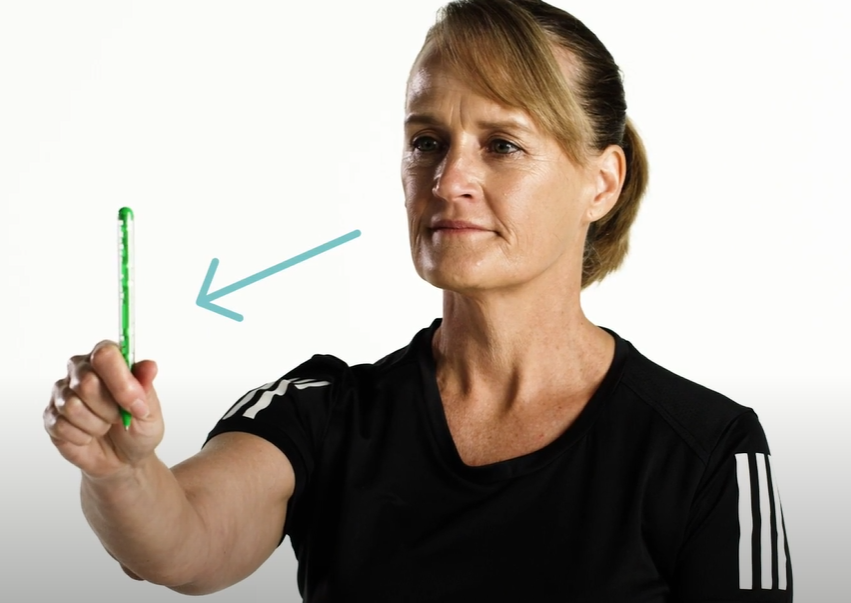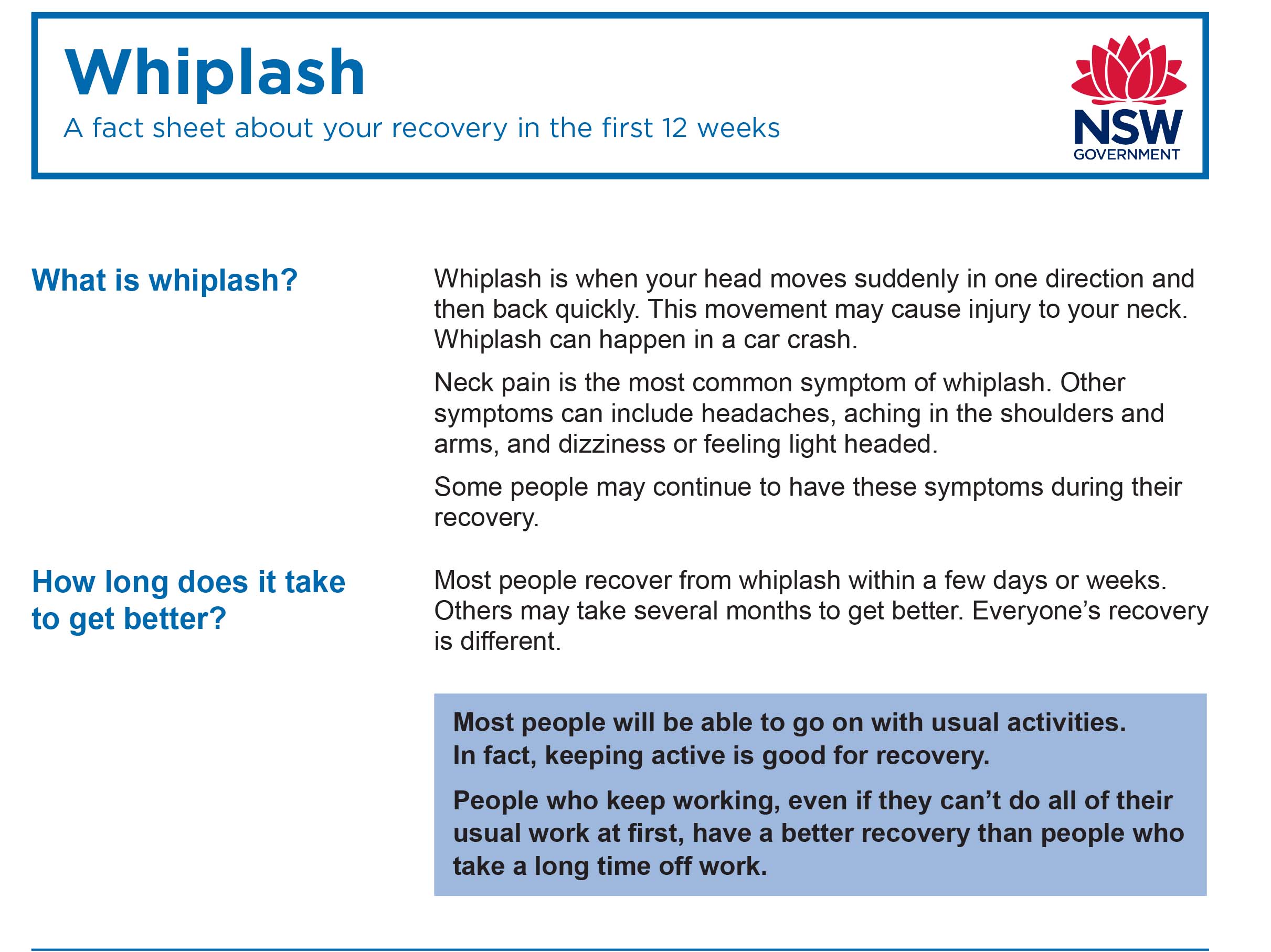Information
and advice
Studies show that people who are positive about recovery and resume their usual daily activities, as much as can be tolerated, may recover faster than those who change or reduce their daily activity levels. For most people, remaining active is important for a quicker recovery.
Click on the topics below to find out more about the road to recovery.
WHAT TO EXPECT AFTER A MOTOR VEHICLE CRASH
What to expect after a vehicle crash
Being in a motor vehicle crash can cause both physical and emotional distress, depending on the nature of the incident. It might be helpful to know that it is common to experience physical symptoms along with emotional responses to a motor vehicle crash.
Physical symptoms may include neck pain, stiffness, headaches, and feeling dizzy or light-headed.
Emotional responses may include feeling upset, anxious or constantly ‘on guard’ or ‘alert’. You may worry about the pain and causing further injury, or feel frustrated and angry about the crash.
You may experience all or none of the above – they are all common responses to being in a car crash and for many people, they resolve in days to weeks. There is no right or wrong way to feel, and everyone’s response is unique to them.
How long will it take to recover?
Each person’s recovery from a motor vehicle crash is different. Recovery from physical and emotional symptoms depends on many factors.
While most people recover well from a whiplash injury, they do so in their own time. Around 50% of people with whiplash recover over days or weeks, however for others it can take longer. No one injury is the same as another.
Source: What to expect on the road to recovery. State Insurance Regulatory Authority.
When to seek professional help?
Recovery can vary. If your symptoms persist without change over a few weeks, it’s important to speak with a healthcare professional (e.g. physiotherapist or GP). Completing this Whiplash assessment questionnaire (WhipPredict) will help your GP or Physiotherapist, guide your recovery. You can complete it online and email it to your health care professional (if they agree) or print it out and take to your next appointment.
Source: What to expect on the road to recovery. State Insurance Regulatory Authority.
What is the role of an insurance case manager?
If you have an accepted compensation claim with your insurer, a insurance case manager can be an important part of your support team.
Your case manager will:
- coordinate and manage the insurance claim process
- work with you, your doctor, other healthcare practitioners and your employer to understand your individual needs
- assist in arranging services to support your recovery and return to normal activities, including work.
You are encouraged to contact the insurance case manager to discuss your claim, recovery needs, or for any enquiries related to payment or treatment expenses.
Source:
Rehabilitation advice - MAIC
Who can help me recover at work? - SIRA (nsw.gov.au)
Injury Recovery and Early Intervention Framework | CTP Insurance Regulator
WHAT IS WHIPLASH?
What is whiplash?
Whiplash describes the forces on the neck when your head moves suddenly in one direction and then back again. It can happen, for example, in rear-end or side- impact motor vehicle crash. This movement can result in injuries to muscles, joints, ligaments and nerves. However, sometimes whiplash results in no injury at all.
Recovering from whiplash
Most people recover well from a whiplash injury, but at different rates. After a whiplash injury, most people will be able to resume their usual activities. A small percentage of people have ongoing pain and experience difficulty resuming usual activities. Research is being conducted to learn more about the differences in recovery rates between different people.
You can take an active role in your recovery from a whiplash injury. In fact, staying active is good for recovery! People who keep working, even if they can't do all of their usual activities at first, tend to have a better recovery than people who take a long time off work.
Completing the Whiplash Assessment Questionnaire (WhipPredict) will help your healthcare professional understand how whiplash is affecting you and how to develop a recovery plan for you. You can complete the assessment online, and the tool provides some recommendations for your recovery. This might include some simple exercises to do, to help you recover.
HOW CAN I HELP MY RECOVERY?
How can I help my recovery?
You can take an active role in your recovery from a whiplash injury in three ways.
1. Stay active
Research shows that staying active helps. Try to keep doing your usual daily activities as much as you can. This will help you recover. Remember that some pain and discomfort is normal during the recovery process. At first, you might need to adapt the way you do some activities to avoid neck strain. Some suggestions are below, but be creative and find new ways so you don't strain your neck.
- Change the side you carry things like bags, laptops, gym bag or babies and toddlers.
- Make more trips to carry less when you are shopping, or carrying items or boxes at home or work.
- Change your posture more often than usual, or get up and move around. Think about doing this if you sit down at work, working on screens (including your phone), watching TV or having dinner with friends and family.
- Do your usual activities over a few days rather than all at once. Vacuum one room each day or mow one section of the garden at a time.
- Avoid reaching overhead. Instead, use a step ladder to maintain correct posture and to bring you to the level of the task to avoid reaching too high.
2. Do your exercises
Daily exercises help support neck flexibility. The recommended exercises are very gentle and usually take about 10 minutes to complete each day.
Click here for instructions and videos on how to do your head and neck exercises.
3. See a healthcare professional
It is important to see a healthcare professional if your symptoms persist after a whiplash injury. They will do a medical check and advise you about treatment. In most cases, X-rays and other tests are not needed for whiplash.
Talk to your health professional about how you can keep working and doing your usual activities during your recovery. They might recommend neck exercises, or suggest you seek advice from another health professional with expertise in whiplash injury.
DAILY ACTIVITIES WITH WHIPLASH
Daily activities with whiplash
People who continue a healthy, active routine after a whiplash injury generally have a better recovery than those who don’t. Gradually increase your activity and exercise levels after your injury, so you can successfully return to your regular activities, hobbies and sports.
Helpful tips are suggested below.
Around the house
- Spread out house cleaning over a few days. You don’t have to do all the household tasks at once.
- Alternate lighter tasks with heavier tasks. For example, do some dusting, vacuum one room, do the washing up, and vacuum another room.
- In the laundry, lift fewer wet clothes from the washing machine at once for top loaders, and use gravity to assist getting clothes out of front-loading washing machines. Avoid lifting heavy baskets of wet clothes to the clothesline. Take several trips with smaller loads of wet clothes.
- If you can, lower the clothesline, and place the washing basket on a trolley to reduce the strain on your neck and shoulders while hanging out the clothes.
Lifting and carrying
- Think before your lift. Test the weight of the item. Avoid reaching to lift objects or lifting awkwardly. Carry objects close to your body.
- Carry fewer bags of groceries from the car at a time. Taking more trips with lighter bags puts less strain on your neck.
- When lifting from ground level, stand close to the object with feet apart, bend using your knees and your back (about 50:50). Keep your chin in during the lift.
Shopping
- Use a cart or trolley to carry oversized or multiple items. At the supermarket, choose a trolley that steers easily when you push it.
With children
- If carrying children, regularly change sides. Use slings if comfortable, backpacks or strollers.
- When nursing or breastfeeding, lie the baby on a pillow on your lap to save having to hold the weight of the baby for prolonged periods during feeds.
- Encourage children to climb onto your lap themselves or into the car to avoid lifting them. Position car seats to limit the amount of reaching you have to do while bending to secure seatbelts.
WORKING WITH WHIPLASH
Working with whiplash
Research shows that continuing to work is good for your health, wellbeing and recovery after a whiplash injury.
You might need to change some of your work routines for a while. Your health professional can give you advice to help you to stay at work while you're recovering from injury.
Helpful tips are suggested below.
- Assess how you spend your day at work. If you sit for a lot of the day, it is important to regularly change positions and take a ‘neck break’. It could be as simple as standing up for a few moments to straighten your spine, or doing a few neck exercises.
- If you work on a computer, arrange your desk, chair and computer to avoid straining your neck. Keep any essential work materials within easy reach.
- Use a headset if your work requires a lot of time on the phone. Avoid cradling the phone between your head and shoulders.
- If you work at a bench, ensure the bench height allows you to work with shoulders and arms relaxed. Benches that are too high can result in raised shoulders, which places extra strain on your neck.
If you can't work straight away, start planning your return to work. The sooner you resume work or study, the better your recovery is likely to be. Speak to your health professional about any support you might need to return to work.
SLEEPING POSTURES FOR WHIPLASH
Sleeping postures for whiplash
The best sleeping posture preserves the natural curvatures of your spine. Lying on your side or on your back is preferred. Avoid sleeping on your stomach, as you must fully turn your neck all night to breathe.
If you are wondering what pillow to use, there is no simple answer. No research points to one type of pillow being better than another. Pillow choice is personal, and you should pick a pillow you find comfortable. You do not necessarily need to change your pillow because you have had a whiplash injury. If your pillow is comfortable, it is right for you.
The principle is that your neck should be supported in a neutral position while you sleep. For example, if you sleep on your side, look in a mirror and check the distance between your ear and the tip of your shoulder. Your pillow height (using one or two pillows of your choice) should match this distance.
Resources
The information on Whiplash Navigator has been developed based on resources from the University of Queensland, the NSW State Insurance Regulatory Authority and the QLD Motor Accident Insurance Commission. Whiplash Navigator is designed to complement information from your health professional and should not be used as a substitute for their advice. Please speak with your health professional if you have any questions and concerns, or you require further information.




